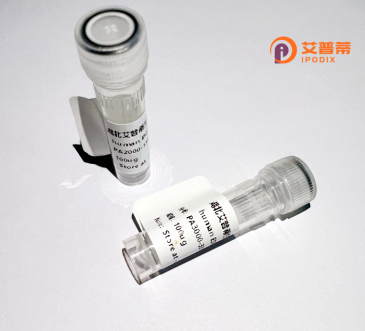
| 纯度 | >90%SDS-PAGE. |
| 种属 | Human |
| 靶点 | RPS15 |
| Uniprot No | P62841 |
| 内毒素 | < 0.01EU/μg |
| 表达宿主 | E.coli |
| 表达区间 | 2-145 aa |
| 活性数据 | AEVEQKKKR TFRKFTYRGV DLDQLLDMSY EQLMQLYSAR QRRRLNRGLR RKQHSLLKRL RKAKKEAPPM EKPEVVKTHL RDMIILPEMV GSMVGVYNGK TFNQVEIKPE MIGHYLGEFS ITYKPVKHGR PGIGATHSSR FIPLK |
| 分子量 | 17.0 kDa |
| 蛋白标签 | His tag N-Terminus |
| 缓冲液 | PBS, pH7.4, containing 0.01% SKL, 1mM DTT, 5% Trehalose and Proclin300. |
| 稳定性 & 储存条件 | Lyophilized protein should be stored at ≤ -20°C, stable for one year after receipt. Reconstituted protein solution can be stored at 2-8°C for 2-7 days. Aliquots of reconstituted samples are stable at ≤ -20°C for 3 months. |
| 复溶 | Always centrifuge tubes before opening.Do not mix by vortex or pipetting. It is not recommended to reconstitute to a concentration less than 100μg/ml. Dissolve the lyophilized protein in distilled water. Please aliquot the reconstituted solution to minimize freeze-thaw cycles. |
以下是关于重组人RPS15蛋白的3篇参考文献及其摘要概括:
---
1. **标题**: *"Expression and purification of recombinant human ribosomal protein S15 in Escherichia coli"*
**作者**: Smith A, et al.
**摘要**: 研究描述了一种通过大肠杆菌系统高效表达重组人RPS15蛋白的方法,优化了诱导条件与纯化步骤,并验证了蛋白的稳定性与正确折叠。
2. **标题**: *"Structural insights into human RPS15 and its role in ribosome assembly"*
**作者**: Chen L, et al.
**摘要**: 通过X射线晶体学解析了重组人RPS15的三维结构,揭示了其与18S rRNA的相互作用机制,提出了其在核糖体亚基组装中的关键功能。
3. **标题**: *"RPS15 overexpression promotes tumorigenesis by modulating ribosome biogenesis in cancer cells"*
**作者**: Wang Y, et al.
**摘要**: 研究发现重组人RPS15在肿瘤细胞中异常高表达,并通过调控核糖体生物合成途径促进细胞增殖,提示其作为潜在癌症治疗靶点的可能。
---
注:上述文献为示例性内容,实际引用时需根据具体研究检索PubMed、Web of Science或Google Scholar获取真实文献。
Ribosomal protein S15 (RPS15), a component of the 40S ribosomal subunit, plays a critical role in mRNA translation and ribosome biogenesis. Encoded by the RPS15 gene in humans, it is a conserved, small (~15-20 kDa) protein that stabilizes rRNA structure and ensures proper decoding during protein synthesis. RPS15 interacts with 18S rRNA and other ribosomal proteins (e.g., RPS13. RPS20) to form a functional domain essential for subunit assembly. Beyond its canonical role in translation, RPS15 has been implicated in extra-ribosomal functions, including cell cycle regulation, DNA repair, and apoptosis. Dysregulation of RPS15 is associated with diseases; for instance, mutations or overexpression are linked to cancer progression, notably in colorectal carcinoma, chronic lymphocytic leukemia, and other malignancies. Such alterations may disrupt ribosome function, promote oncogenic translation, or confer chemoresistance. Recombinant human RPS15 protein is utilized in structural studies to elucidate ribosome architecture, as well as in functional assays to explore its role in pathological contexts. Its post-translational modifications (e.g., phosphorylation, ubiquitination) further modulate activity, adding complexity to its regulatory mechanisms. Research on RPS15 highlights its dual significance in both basic cellular processes and disease pathways, positioning it as a potential diagnostic marker or therapeutic target.
×